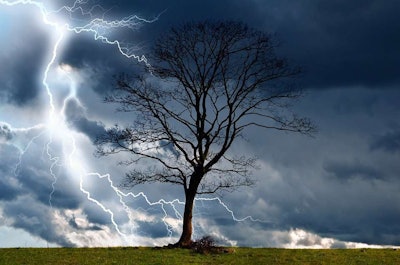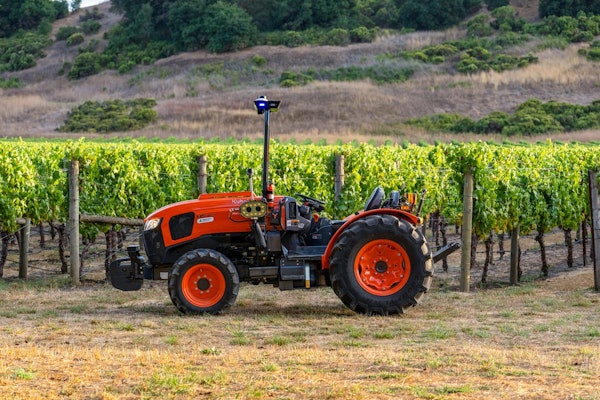
 Federal regulators say workers should get to a safe place at the first sign of an approaching thunderstorm.
Federal regulators say workers should get to a safe place at the first sign of an approaching thunderstorm.Photo: pixabay.com
EDITOR’S NOTE: Lightning strikes can severely injure or kill landscape workers and others whose jobs involve working outdoors, yet lightning is often overlooked as an occupational hazard. The following lightning safety recommendations were compiled by the Occupational Safety and Health Administration (OSHA) and the National Oceanic and Atmospheric Administration (NOAA).
Lightning is a dangerous natural force. Each year in the United States, cloud-to-ground lightning occurs 20 to 25 million times and more than 300 people are struck by lightning. During the past 30 years, about 50 people, on average, have been killed by lightning strikes every year, and many more suffer permanent disabilities.
Precautions should be taken to prevent worker exposure to lightning. Employers should recognize lightning as an occupational hazard. Supervisors and workers at outdoor worksites should take lightning safety seriously.
Workers whose jobs involve working outdoors in open spaces, on or near tall objects or near explosives or conductive materials such as metal have significant exposure to lightning risks. Landscaping and lawn service workers among those at higher risk for lightning hazards.
Reducing lightning hazards for workers
Employers, supervisors and workers should understand lightning risks, characteristics and precautions to minimize workplace hazards. Lightning is unpredictable and can strike outside the heaviest rainfall areas or even up to 10 miles from any rainfall.
Many lightning victims are caught outside during a storm because they did not act promptly to get to a safe place, or they go back outside too soon after a storm has passed.
If signs of approaching thunderstorms occur, workers should not begin any task they cannot quickly stop. Proper planning and safe practices can easily increase lightning safety when working outdoors.
If you hear thunder – even a distant rumble – get to a safe place immediately. Thunderstorms always include lightning. In fact, any thunder you hear is caused by lightning. According to NOAA, nowhere outside is safe when thunderstorms are in your area.
OSHA and NOAA recommend that employers and supervisors follow these lightning safety best practices for workers whose jobs involve working outdoors:
- Check NOAA weather reports: Prior to beginning any outdoor work, employers and supervisors should check NOAA weather reports (weather.gov) and radio forecasts for all weather hazards. OSHA recommends that employers consider rescheduling jobs to avoid workers being caught outside in hazardous weather conditions. When working outdoors, supervisors and workers should continuously monitor weather conditions. Watch for darkening clouds and increasing wind speeds, which can indicate developing thunderstorms. Pay close attention to local television, radio and internet weather reports, forecasts and emergency notifications regarding thunderstorm activity and severe weather.
- Seek shelter in buildings: Employers and supervisors should know and tell workers which buildings to go to after hearing thunder or seeing lightning. NOAA recommends seeking out fully enclosed buildings with electrical wiring and plumbing. Remain in the shelter for at least 30 minutes after hearing the last sound of thunder.
- Vehicles as shelter: If safe building structures are not accessible, employers should guide workers to hard-topped metal vehicles with rolled up windows. Remain in the vehicle for at least 30 minutes after hearing the last sound of thunder.
- Phone Safety: After hearing thunder, do not use corded phones, except in an emergency. Cell phones and cordless phones may be used safely.
Prepare an emergency action plan
Employers should have a written emergency action plan (EAP), as required by federal regulations. The EAP should include a written lightning safety protocol for outdoor workers. This lightning safety protocol should:
- Inform supervisors and workers to take action after hearing thunder, seeing lightning, or perceiving any other warning signs of approaching thunderstorms.
- Indicate how workers are notified about lightning safety warnings.
- Identify locations and requirements for safe shelters.
- Indicate response times necessary for all workers to reach safe shelters.
- Specify approaches for determining when to suspend outdoor work activities and when to resume outdoor work activities.
- Account for the time required to evacuate customers and members of the public, and the time needed for workers to reach safety.
Employers should also post information about lightning safety at outdoor worksites. All employees should be trained on how to follow the EAP, including the lightning safety procedures.
Lightning safety training
Employers should adequately train all workers on lightning safety. Training should be provided for each outdoor worksite, so that supervisors and workers know in advance where a worksite’s safe shelters are and the time it takes to reach them. Employers should train supervisors and workers to provide lightning safety warnings in sufficient time for everyone to reach a worksite’s safe shelters and take other appropriate precautions.
An employer’s EAP may include lightning warning or detection systems, which can provide advance warning of lightning hazards. However, no systems can detect the “first strike,” detect all lightning or predict lightning strikes. NOAA recommends that employers rely on NOAA weather reports, including NOAA Weather Radio All Hazards.
Commercial lightning detection and notification services are available to monitor for lightning activity. These notification services can send alerts when lightning activity develops or moves to within a certain range of a work site.
In addition, these commercial systems can provide mapped locations of lightning strikes from an approaching storm. However, these systems cannot predict the first lightning strike.
In some cases, simply listening for thunder or watching the sky may be a better indication of a developing or nearby storm.
If caught outside in a thunderstorm
If you find yourself caught outside during a thunderstorm, there may be nothing you can do to prevent being struck by lightning. There simply is no safe place outside in a thunderstorm. This is why it is very important to get to a safe place at the first signs of a thunderstorm. If you are caught outside follow NOAA’s recommendations to decrease the risk of being struck.
Lightning is likely to strike the tallest objects in a given area. You should not be the tallest object.
Avoid isolated tall trees, hilltops, utility poles, cell phone towers, cranes, large equipment, ladders, scaffolding or rooftops.
Avoid open areas such as fields. Never lie flat on the ground.
Retreat to dense areas of smaller trees that are surrounded by larger trees, or retreat to low-lying areas (valleys, ditches), but watch for flooding.
Avoid water and immediately get out of and away from bodies of water. Water does not attract lightning, but it is an excellent conductor of electricity.
Avoid wiring, plumbing and fencing. Lightning can travel long distances through metal, which is an excellent conductor of electricity. Stay away from all metal objects, equipment and surfaces that can conduct electricity.
Do not shelter in sheds, pavilions, tents, or covered porches, as they do not provide adequate protection from lightning. Seek fully enclosed, substantial buildings with wiring and plumbing.
In modern buildings, the interior wiring and plumbing will act as an earth ground. A building is a safe shelter as long as you are not in contact with anything that can conduct electricity (electrical equipment or cords, plumbing fixtures, corded phones). Do not lean against concrete walls or doors (which may have metal bars inside).









